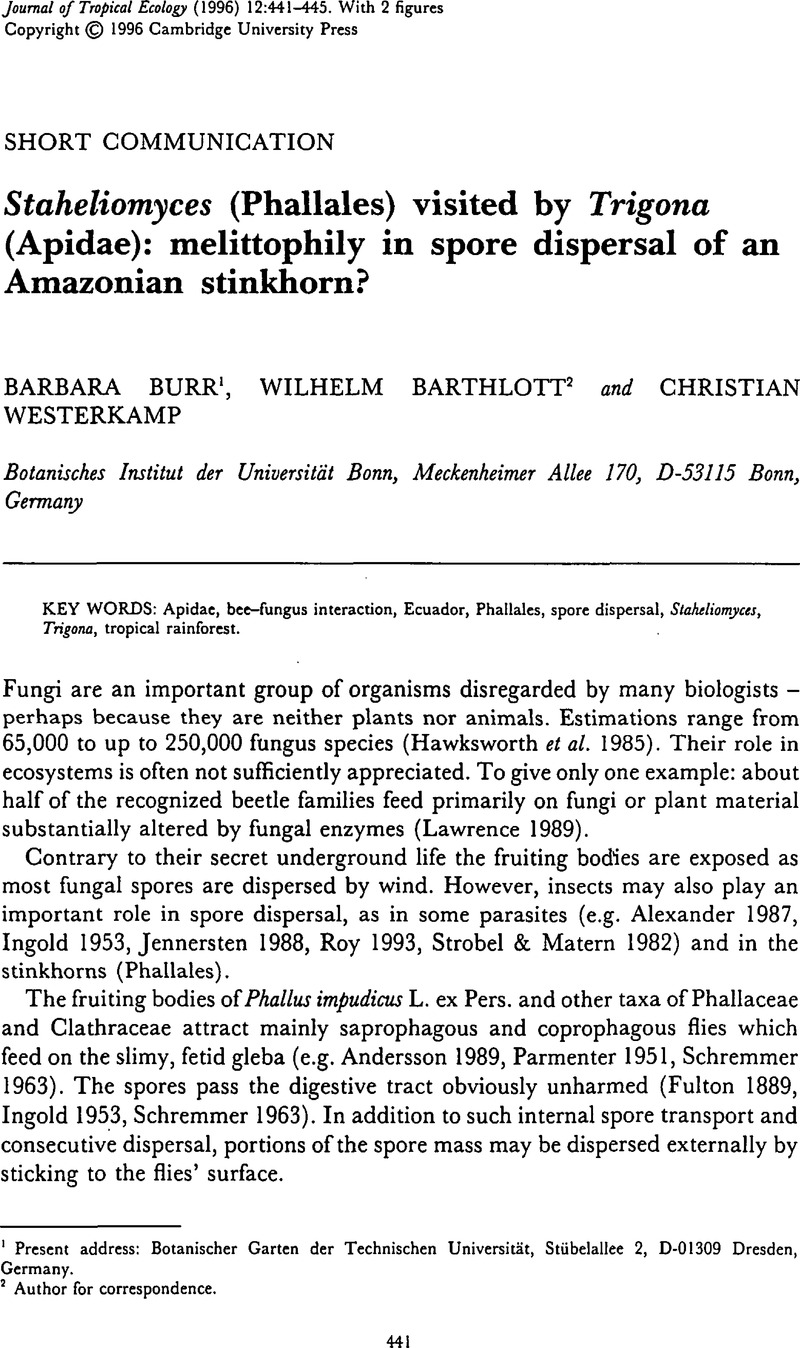Crossref Citations
This article has been cited by the following publications. This list is generated based on data provided by Crossref.
Oliveira, Marcio L.
and
Morato, Elder F.
2000.
Stingless bees (Hymenoptera, Meliponini) feeding on stinkhorn spores (Fungi, Phallales): robbery or dispersal?.
Revista Brasileira de Zoologia,
Vol. 17,
Issue. 3,
p.
881.
Menezes, Cristiano
Vollet-Neto, Ayrton
Contrera, Felipe Andrés Felipe León
Venturieri, Giorgio Cristino
and
Imperatriz-Fonseca, Vera Lucia
2013.
Pot-Honey.
p.
153.
Tang, Xiaozhao
Mi, Fei
Zhang, Ying
He, Xiaoxia
Cao, Yang
Wang, Pengfei
Liu, Chunli
Yang, Dan
Dong, Jianyong
Zhang, Keqing
and
Xu, Jianping
2015.
Diversity, population genetics, and evolution of macrofungi associated with animals.
Mycology,
Vol. 6,
Issue. 2,
p.
94.
2016.
Fungi in Ecosystem Processes, Second Edition.
p.
191.
Salgado-Neto, Geraldo
Vaz, Marcos André Braz
Guedes, Jerson Vanderlei Carús
Muniz, Marlove Fátima Brião
and
Blume, Elena
2016.
Fusarium oxysporum dispersion by larvae of Cyclocephala modesta, Dyscinetus gagates and Diloboderus abderus in Brazil.
Ciência Rural,
Vol. 46,
Issue. 6,
p.
943.
Yamashita, Satoshi
Hisamatsu, Sadatomo
Maruyama, Munetoshi
Meleng, Paulus
and
Itioka, Takao
2018.
Coleopteran Insects Collected from the Fruiting Bodies of Dictyophora spp. (Phallaceae) in a Bornean Tropical Rainforest.
The Coleopterists Bulletin,
Vol. 72,
Issue. 1,
p.
134.
Kües, Ursula
Khonsuntia, Weeradej
Subba, Shanta
and
Dörnte, Bastian
2018.
Physiology and Genetics.
p.
149.
Grüter, Christoph
2020.
Stingless Bees.
p.
273.
Cabral, Tiara S.
Melanda, Gislaine C. S.
de Assis, Nathalia Mendonça
Ovrebo, Clark
Baseia, Iuri Goulart
and
Martín, María P.
2022.
Loosening the belt: unknown diversity of the strangled stinkhorn genus Staheliomyces (Phallales, Basidiomycota).
Mycological Progress,
Vol. 21,
Issue. 4,
ASSIS, Nathalia Mendonça de
GÓIS, Jefferson dos Santos
FREITAS-NETO, Julimar Freire de
BARBOSA, Flávia Rodrigues
and
BASEIA, Iuri Goulart
2022.
Checklist of Amazonian gasteroid fungi (Agaricomycetidae, Phallomycetidae, Basidiomycota).
Acta Amazonica,
Vol. 52,
Issue. 2,
p.
131.
Ribeiro, Mateus Santana
Cabral, Tiara Sousa
Melanda, Gislaine Cristina Souza
Baseia, Iuri Goulart
and
Silva, Bianca Denise Barbosa da
2022.
Funga faloide e floriforme (Phallales, Basidiomycota) no Estado da Bahia, Brasil..
Hoehnea,
Vol. 49,
Issue. ,
Santana, Marcos Diones Ferreira
and
Couceiro, Sheyla Regina Marques
2024.
New insights on the spore dispersal of Phallus indusiatus s.l. (Basidiomycota, Phallaceae) for the Brazilian Amazon forest.
Food Webs,
Vol. 38,
Issue. ,
p.
e00338.
He, Mao-Qiang
Cao, Bin
Liu, Fei
Boekhout, Teun
Denchev, Teodor T.
Schoutteten, Nathan
Denchev, Cvetomir M.
Kemler, Martin
Gorjón, Sergio P.
Begerow, Dominik
Valenzuela, Ricardo
Davoodian, Naveed
Niskanen, Tuula
Vizzini, Alfredo
Redhead, Scott A.
Ramírez-Cruz, Virginia
Papp, Viktor
Dudka, Vasiliy A.
Dutta, Arun Kumar
García-Sandoval, Ricardo
Liu, Xin-Zhan
Kijpornyongpan, Teeratas
Savchenko, Anton
Tedersoo, Leho
Theelen, Bart
Trierveiler-Pereira, Larissa
Wu, Fang
Zamora, Juan Carlos
Zeng, Xiang-Yu
Zhou, Li-Wei
Liu, Shi-Liang
Ghobad-Nejhad, Masoomeh
Giachini, Admir J.
Li, Guo-Jie
Kakishima, Makoto
Olariaga, Ibai
Haelewaters, Danny
Sulistyo, Bobby
Sugiyama, Junta
Svantesson, Sten
Yurkov, Andrey
Alvarado, Pablo
Antonín, Vladimír
da Silva, André Felipe
Druzhinina, Irina
Gibertoni, Tatiana B.
Guzmán-Dávalos, Laura
Justo, Alfredo
Karunarathna, Samantha C.
Galappaththi, Mahesh C. A.
Toome-Heller, Merje
Hosoya, Tsuyoshi
Liimatainen, Kare
Márquez, Rodrigo
Mešić, Armin
Moncalvo, Jean-Marc
Nagy, László G.
Varga, Torda
Orihara, Takamichi
Raymundo, Tania
Salcedo, Isabel
Silva-Filho, Alexandre G. S.
Tkalčec, Zdenko
Wartchow, Felipe
Zhao, Chang-Lin
Bau, Tolgor
Cabarroi-Hernández, Milay
Cortés-Pérez, Alonso
Decock, Cony
De Lange, Ruben
Weiss, Michael
Menolli, Nelson
Nilsson, R. Henrik
Fan, Yu-Guang
Verbeken, Annemieke
Gafforov, Yusufjon
Meiras-Ottoni, Angelina
Mendes-Alvarenga, Renato L.
Zeng, Nian-Kai
Wu, Qi
Hyde, Kevin D.
Kirk, Paul M.
and
Zhao, Rui-Lin
2024.
Phylogenomics, divergence times and notes of orders in Basidiomycota.
Fungal Diversity,
Vol. 126,
Issue. 1,
p.
127.



